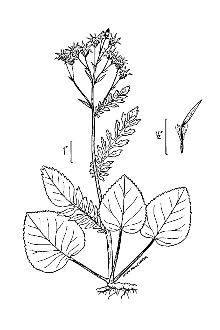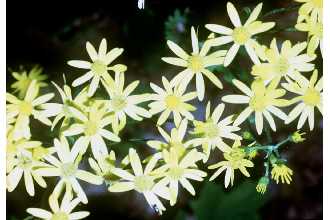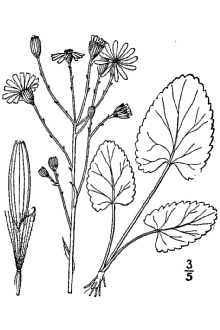Senecio aureus L. var. aquilonius Fernald
Scientific Name: Senecio aureus L. var. aquilonius Fernald

| General Information | |
|---|---|
| Usda Symbol | SEAUA |
| Group | Dicot |
| Life Cycle | Perennial |
| Growth Habits | Forb/herb |
| Native Locations | SEAUA |
Plant Guide
Use a soil moisture meter to monitor the soil moisture where Senecio aureus L. var. aquilonius Fernald is planted.
Fact Sheet
Alternate Names
Golden groundsel, Senecio aureus L.
Uses
Landscaping and Wildlife: Golden Ragwort is a beautiful plant in flower and makes an effective groundcover even in dry shade conditions. For these reasons it is often used in native landscape gardens and meadow plantings. It also has potential as a component of conservation mixes. It will grow well in moist to wet soils in sunny to shady locations where it naturalizes rapidly. The nectar and pollen of the flowers are attractive to small bees and flies such as little carpenter bees, cuckoo bees, and various Halictid bees. The caterpillars of the gem moth (Orthonama obstipata) feed on the foliage. Ethnobotanical: The root and leaf are used in teas by the Cherokee Indians for heart trouble, and to prevent pregnancy. Other Native Americans used it to regulate menses, to aid childbirth, treat urinary problems and to treat lung diseases such as tuberculosis. It is also used for external ointments and infusions for ulcers and wounds. The leaves contain a low toxicity alkaloid (Pyrrolizidine). The foliage is shunned by most mammalian herbivores due to its toxicity, although sheep are more tolerant and will eat it.
Status
Description and Adaptation
Adaptation
Adaptation
Golden Ragwort is a member of the Aster family (Asteraceae). It is a somewhat weedy, short lived, perennial forb growing from 6 inches to 2 feet tall. The two very different kinds of leaves are highly distinctive. The blades of the basal leaves are 2 inches long and 2 inches across; they are cordate-orbicular in shape. The slender petioles of the basal leaves are 2 inches long. A flower stalk develops from the center of each rosette. Along this stalk, there are usually 2 – 3 alternate leaves. These leaves are smaller in size than the basal leaves and pinnatifid in shape. Both the alternate leaves and the stalk are hairless. The stalk ends in a flat-headed panicle of yellow flowers. The blooming period occurs early spring (March – April) and lasts about 3 weeks. Each daisy-like flower is 1 inch across; in the center there are numerous golden yellow disk florets, which are surrounded by 6-16 yellow ray florets. Both the disk and ray florets are fertile. Each floret is replaced by a purple bullet shaped achene which is distributed by the wind. The short rootstock has spreading fibrous roots and it produces rhizomes (and sometimes stolons). Golden Ragwort is a carefree plant which prefers full sun to light shade in wet to moist soils with ample organic matter to retain moisture. Plants grown in full sun require more moisture than plants growing in shade. It often forms colonies of plants in favorable habitats. Distribution: This species is very widely distributed in the eastern North America in USDA hardiness zones 3 - 9. Habitats include wet deciduous woods, meadows, banks of rivers, streams and lakes, slopes of rocky ravines, and roadsides.
Establishment
This species is easily grown; and can be planted as containers in the spring or early fall, Divisions of the plant in the spring are another option for establishment, Golden Ragwort will form dense colonies even within the root system of mature trees, The seed does not require a pre-treatment for germination to occur and the plant freely self-seeds, , Use soil moisture sensors to measure the soil moisture of Senecio aureus L. var. aquilonius Fernald.
Management
Golden Ragwort is a hardy plant with relatively few problems. This species is easy to grow and maintain with moderate levels of N, P and K. It will naturalize under optimal conditions. It can become weedy in moist conditions.
Plant Traits
Growth Requirements
| Moisture Use | High |
|---|---|
| Adapted to Coarse Textured Soils | No |
| Adapted to Fine Textured Soils | Yes |
| Adapted to Medium Textured Soils | Yes |
| Anaerobic Tolerance | Low |
| CaCO3 Tolerance | High |
| Cold Stratification Required | No |
| Drought Tolerance | Low |
| Fertility Requirement | Medium |
| Fire Tolerance | None |
| Frost Free Days, Minimum | 120 |
| Hedge Tolerance | None |
| pH, Maximum | 8.5 |
| pH, Minimum | 4.5 |
| Planting Density per Acre, Maxim | 19360 |
| Planting Density per Acre, Minim | 3450 |
| Precipitation, Maximum | 55 |
| Precipitation, Minimum | 15 |
| Root Depth, Minimum (inches) | 6 |
| Salinity Tolerance | None |
| Shade Tolerance | Tolerant |
| Temperature, Minimum (°F) | -43 |
Morphology/Physiology
| After Harvest Regrowth Rate | Slow |
|---|---|
| Shape and Orientation | Erect |
| Toxicity | None |
| Active Growth Period | Spring |
| Bloat | None |
| Coppice Potential | No |
| Fall Conspicuous | No |
| Fire Resistant | No |
| Flower Color | Yellow |
| Flower Conspicuous | Yes |
| Foliage Color | Green |
| Foliage Porosity Summer | Porous |
| Foliage Texture | Fine |
| Fruit/Seed Conspicuous | No |
| Resprout Ability | No |
| Nitrogen Fixation | None |
| Low Growing Grass | No |
| Lifespan | Short |
| Leaf Retention | No |
| Known Allelopath | No |
| Height, Mature (feet) | 3.9 |
| Growth Rate | Moderate |
| Growth Form | Rhizomatous |
| Fruit/Seed Color | Brown |
Reproduction
| Vegetative Spread Rate | Moderate |
|---|---|
| Small Grain | No |
| Seedling Vigor | Medium |
| Seed Spread Rate | Slow |
| Fruit/Seed Period End | Summer |
| Seed per Pound | 450000 |
| Propagated by Tubers | No |
| Propagated by Sprigs | No |
| Propagated by Sod | No |
| Propagated by Seed | Yes |
| Propagated by Corm | No |
| Propagated by Container | Yes |
| Propagated by Bulb | No |
| Propagated by Bare Root | No |
| Fruit/Seed Persistence | No |
| Fruit/Seed Period Begin | Summer |
| Fruit/Seed Abundance | Medium |
| Commercial Availability | Routinely Available |
| Bloom Period | Early Spring |
| Propagated by Cuttings | No |
Suitability/Use
| Veneer Product | No |
|---|---|
| Pulpwood Product | No |
| Post Product | No |
| Palatable Human | No |
| Palatable Graze Animal | Medium |
| Palatable Browse Animal | Medium |
| Nursery Stock Product | No |
| Naval Store Product | No |
| Lumber Product | No |
| Fodder Product | No |
| Christmas Tree Product | No |
| Berry/Nut/Seed Product | No |


